
AUSA 2022: Disruptive Technology Or Old Wine?

The Association of the United States Army (AUSA) Annual Meeting (AM) is the largest land power exposition forum in the USA, with a global canvas. Taking place over three days, the AM focuses on showcasing holistic development of the Land Forces. The theme for AUSA 2022, held in Washington DC from 10 to 12 October 2022, was ‘Building The Army of 2030’ with focus on ‘continued transformation’ and was designed to ‘deliver the Army’s message by highlighting the capabilities of Army organizations and presenting a wide range of industry products and services’.
AUSA 2022 comes in the midst of the US Defence Force’s multi-front deployment, focusing on Europe and the Indo-Pacific, to cater for existing global security challenges including the Russia-Ukraine War.
AUSA 2022 had a footfall of close to 65,000 visitors/ attendees, with about 700 exhibitors from more than 80 countries.
Technology Demonstrated at AUSA 2022
This article focuses on some of the important cutting-edge military technology displayed at AUSA 2022 as also product improvements in existing platform/weapon system designs that might find relevance/be of interest in the purview of the Indian Armed Forces’ push to modernise and develop/incorporate disruptive technologies in the near future. These are enumerated in succeeding paragraphs.
Raider-X Fast Reconnaissance Helicopter: Lockheed Martin (LM). The Raider-X has been developed by LM in response to the US Army’s Future Attack Reconnaissance Aircraft (FARA) prototype competition for vertical-lift aerial platforms. The fully composite coaxial main rotors and a rear-facing ‘pusher’ tail-rotor, along with fly-by-wire controls, composite fuselage and retractable landing gear, provide enhanced responsiveness/manoeuvrability, greater top speed/reduced drag, enhanced low-speed hover, more efficient acceleration/braking and longevity due to corrosion-resistance. Operational flexibility is enhanced with an internal auxiliary fuel tank for extended range /increased endurance, additional ammunition capacity and aerial refuelling capability. With a max all-up weight of just over 5 tons, the Raider would enjoy an endurance of approximately 3 hours, range in excess of 600 Km and a top speed of 239 Knots (~444 Kmph) making it one of the fastest helicopters in the world! The weapons package would include Hellfire missiles, 2.75″ rockets, 0.50 calibre under-nose gun and 7.62 mm machine-gun. The open-systems architecture-based avionics and mission systems would offer “plug-and-play” options for computing, sensors, survivability and weapons package, facilitating mission-specific tailoring and enhancing suitability for the global market. The significant enhancement in speed/agility over most current military helicopters makes the Raider-X’s disruptive design worth looking at for similar development/employability in the context of the Indian Armed Forces, in open as well as mountainous terrain, for myriad combat/ combat-support functions, either as an ab-initio design or by way of product improvement of existing platforms.

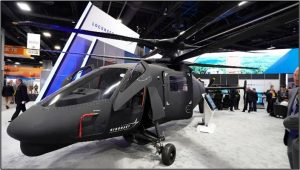
LM’s Raider-X Fast Reconnaissance Helicopter: Source- lockheedmartin.com/breakingdefense.com
Armoured Multi-Purpose Vehicle (APMV): BAE Systems. The APMV Program was initiated when in 2014, the US Army selected BAE Systems to develop a turretless variant of the Bradley Combat Vehicle. The APMV Program will deliver 2907 platforms at an approximate cost of US$ 4 Million per vehicle, to replace the 2800+ vintage M113 Armoured Personnel Carriers (APC). As of 2022, five variants of the AMPV are planned: General Purpose Vehicles (522)- 2 crew + 6 troops with crew-served weapon, Mission Command Vehicles (993)- with crew served weapon, Mortar Carrier Vehicles (386)- 2 crew + 2 mortar operators with a 120 mm mortar and 69 mortar rounds, Medical Evacuation Vehicles (790)- 2 crew + 6/3 ambulatory or 4/2 lying patients; and Medical Treatment Vehicles (216)- 4 crew + 1 lying patient. Series production commenced in September 2020.

General Purpose/Mission Command and Medical Evac/Medical Treatment APMV Displayed by BAE Systems: Source-breakingdefense.com
Mobile Counter Unmanned Aerial System (UAS) Systems
- Mobile Sentry: Anduril. ‘Mobile Sentry’ counter-Unmanned Aerial System (C-UAS) is a multi-mission, ruggedised mobile platform that uses AI and multiple sensors for persistent, 360º C-UAS surveillance. Mobile Sentry builds on the success of the Sentry Tower, presently in operational service with the US Army since 2020 for autonomous surveillance and integrated base defence/C-UAS. Mobile Sentry can be customised with a variety of sensors/payloads/communications equipment for autonomous force protection and C-UAS operations for sensitive military/logistic installations, command nodes and deployed forces. The system can be deployed, set-up, calibrated and made operational in under 20 minutes by one operator. It has an endurance of 100 hours with full fuel and is free-standing, with integrated power generation and uninterrupted power supply solutions, making it durable and efficient in field conditions. The system is capable of off-road towing and is air-transportable by fixed and rotary-wing aircraft.
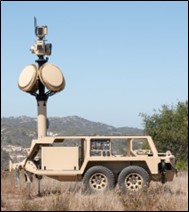
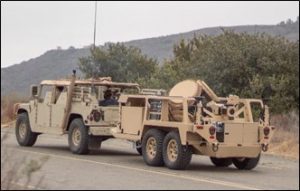
Anduril’s ‘Mobile Sentry’ System: Source- unmannedairspace.info/ blog.anduril.com
- Stryker Leonidas Counter-UAS System: Epirus/General Dynamics. Technology company Epirus with General Dynamics Land Systems has integrated Leonidas, a high-power microwave (HPM) phased array onto the Stryker Combat Vehicle, equipped with a directed energy weapon, to produce the Stryker-Leonidas- a mobile C-UAS and counter-electronics system for the US Army’s manoeuvre forces. The system has been field tested and unveiled at AUSA 2022. Stryker-Leonidas is the latest edition to Epirus’ suite of HPM systems – along with its ground-based surface-to-air AD system and the Leonidas Pod- a first-of-its kind, mobile and compact HPM system. When deployed in tandem, these systems provide layered counter-swarm and counter-electronics protection. With open architecture, the system can integrate with a range of command-and-control platforms to detect, track and neutralize individual UAS as well as drone swarms. In doing so, the system plugs a gap in the US Army’s short-range C-UAS capabilities.

Stryker-Leonidas: Source-epirusinc.com
In the context of the Indian Armed Forces, DRDO has developed the D4 C-UAS system which has been actively deployed on numerous occasions. Mobile C-UAS systems offering persistent, 360º surveillance would need to be the focus to provide deployed forces and military bases the wherewithal to deal with this ever-increasing, unobtrusive threat.
Lynx Optionally Manned Fighting Vehicle (OMFV)/Expeditionary Modular Autonomous Vehicle (EMAV): Raytheon Rheinmetall Land Systems/Pratt Miller Defence.
- The Lynx OMFV is a next-generation, tracked OMFV built in response to the US Army’s OMFV Program. A life-sized concept demonstrator was unveiled at AUSA 2022. The OMFV is AI-enabled and operates with two crew members and a third virtual crew member for surveillance, threat identification and warning, thus achieving a high degree of situational awareness and survivability. It can also operate unmanned, to perform high-risk missions without danger to crew. The Lynx OMFV uses augmented-reality to assist it in its functions. It mounts a RCWS with a 50mm cannon, optionally mounted machine guns, as also Raytheon’s new Multi-Mission Launcher which can fire TOW/Javelin ATGMs and the Coyote Block 3 loitering munition. The sensor package includes a Third Generation Forward Looking Infra- Red (FLIR) suite along with other sensors to enhance the ‘hunter-killer’ capabilities. The Lynx OMFV hosts modular structural architecture, thus enabling the OMFV to be tailored for mission/ threat-specific requirements and reducing the cost/time involved for future upgrades/replacements.

Lynx OMFV: Source-ptisidiastima.com
- The EMAV is a tracked, unmanned autonomous vehicle, contracted by the US Army as part of the Next-Generation Combat Vehicle (NGCV) Program, to provide tactical Infantry support at the platoon level. The EMAV weighs approximately 3000 Kg and can carry an astounding 3265 Kg payload at speeds of up to 72 Kmph! The EMAV sports hybrid propulsion and can climb 60% gradient and vertical steps up to 2 feet. The EMAV can mount a variety of sensor payloads and a RCWS. Three control options are available for the EMAV – local, tele-operation, or autonomous – with a common controller being used for the vehicle/payload systems. The EMAV can be paired with other platforms/combat vehicles for Manned-Unmanned Teaming. It is air transportable by fixed/rotary wing platforms.

Rheinmetall’s EMAV: Source-overtdefense.com
The GMC Hummer Electric Vehicle (EV) Platform/HUMVEE Saber ‘Blade’: General Motors (GM).
- The GMC Hummer EV has been developed by GM Defence (the division of GM focussed on military mobility) in response for a Request for Information (RFI) floated by the US Army. It is based on the Hummer EV, with modified frame, dual/tri-motors and 400/800 Volt Lithium-Ion batteries. The EV can be charged through dedicated static charging bays in peace/mobile charging units in operational areas. The US Army is likely to switch to logistics EVs first before tactical EVs enter their folds. The initial version of the 4 Ton EV would have a range of 529 Km on one charge. Presently, series production combat/reconnaissance/logistic EVs have great potential for absorption into the Indian Armed Forces, with the concurrent induction of static/ mobile charging bays, which could significantly reduce costs related to use of fossil fuels by contemporary combat/logistic vehicles held in the inventory.
- The Saber Blade is a High-Mobility Multipurpose Wheeled Vehicle (HMMWV) based on the HUMVEE Saber Light Tactical Vehicle. The 4×4 HMMWV enjoys an enhanced level of protection including a protected crew compartment and blast protection for the front and rear wheels. Additional safety features include an advanced occupancy protection restraint system, modular blast seats and ‘transparent’ armour, making it mine and IED resistant. The Saber Blade can carry up to 10 Switchblade 600 loitering munitions in specific launch tubes and four Switchblade 300 drones in specially built cells, controlled by the Hornet Air Guard Remote Controlled Weapon System (RCWS) turret mounted on its roof. The Air Guard RCWS includes an imaging sensor, radar and a 40mm automatic grenade launcher with airburst ammunition intended primarily for detection and neutralisation of UAS.

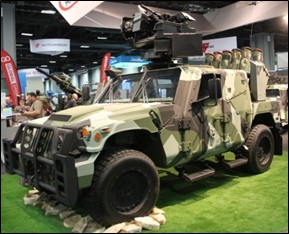
The HUMVEE Saber Blade/ GMC Hummer Electric Vehicle (EV) Platform: Source-shephardmedia.com/ breakingdefense.com
Mission Master CXT Unmanned Ground Vehicle (UGV)/ Ghost-Vision 60 Q UGV: Rheinmetall/ Ghost Robotics.
- The Mission Master CXT from Rheinmetall is a rugged, all-terrain autonomous UGV (A-UGV) meant for employment with troops. The A-UGV exhibits high terrain-mobility, hybrid propulsion (diesel/electric) and amphibious capability and can transport loads up to 1000 Kg, with low noise levels. The hybrid propulsion provides a total range of 450 Km (including 50 Km on Lithium-Ion batteries) without refuelling. The A-UGV is air-transportable as internal load by fixed/rotary wing aircraft, including the C-17/C-130 strategic lift aircraft and Chinook helicopters.
- The Ghost-Vision UGV is a mid-sized high-endurance, all-terrain UGV which finds application in urban and remote environments for Improvised Explosive Device (IED) detection/neutralisation, reconnaissance/surveillance including for CBRN, communication relay, payload delivery and other functions. It has an endurance of up to 10 hours and can travel 12 Km in 3 hours on a single charge. It has capabilities of persistent autonomy, ‘object avoidance and ‘blind locomotion’- wherein the UGV is capable of manoeuvring even after complete loss of vision sensors. It is also capable of GPS-denied self-location using odometry and sensor fusion- an imperative aspect in rural operations.
- One of the entries in the Compendium of Problem Statements- 2020, an Indian Army Design Bureau (ADB) publication that seeks tailor-made technology for the Indian Army (IA), is the Tactical UGV for close-quarters surveillance/combat, scripted in consonance with the UGV employment philosophy of the IA. DRDO’s Daksh, Sooran and Mobile Autonomous Robotic System (MARS) combat/counter-IED UGVs developed by Chennai-based start-ups, are examples of indigenous projects. The DRDO roadmap for UGVs envisions development of network-centric autonomous tracked UGVs in offensive combat roles by 2025.


Mission Master CXT A-UGV/Ghost Robotics Ghost Vision 60 Q UGV: Source- rheinmetall-defence.com/breakingdefense.com
Modular Vehicle Protection Platform (MVPP)-Globe Tech. The MVPP is a vehicle add-on mine-roller cum protection platform that can withstand IED blasts, thus according protection to the parent vehicle. The design finds extensive application in the context of the Indian Armed Forces deployed in counter-terrorist/ counter-insurgency roles that have to face the threat of IEDs on a daily basis. The design also finds application for India’s Central Armed Police Forces which are deployed for anti-Naxalite operations in the hinterland.

MVPP: Source-breakingdefense.com
Conclusion
AUSA 2022 provided an eclectic mix of neo-technology along with long-awaited and desired upgrades to existing combat platforms. While direct requisitions may not find priority over the self-reliance drive for ‘Make in India’, it would be prudent to examine such technologies in the light of operational requirements for the Indian Armed Forces and pace own indigenous development/ partnerships accordingly, to leverage global cutting-edge technology for our Armed Forces.
Disclaimer
The opinions expressed in this article are the author’s own and do not reflect the views of Chanakya Forum. All information provided in this article including timeliness, completeness, accuracy, suitability or validity of information referenced therein, is the sole responsibility of the author. www.chanakyaforum.com does not assume any responsibility for the same.
Chanakya Forum is now on . Click here to join our channel (@ChanakyaForum) and stay updated with the latest headlines and articles.
Important
We work round the clock to bring you the finest articles and updates from around the world. There is a team that works tirelessly to ensure that you have a seamless reading experience. But all this costs money. Please support us so that we keep doing what we do best. Happy Reading
Support Us





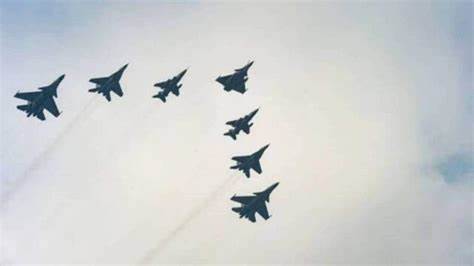















POST COMMENTS (0)